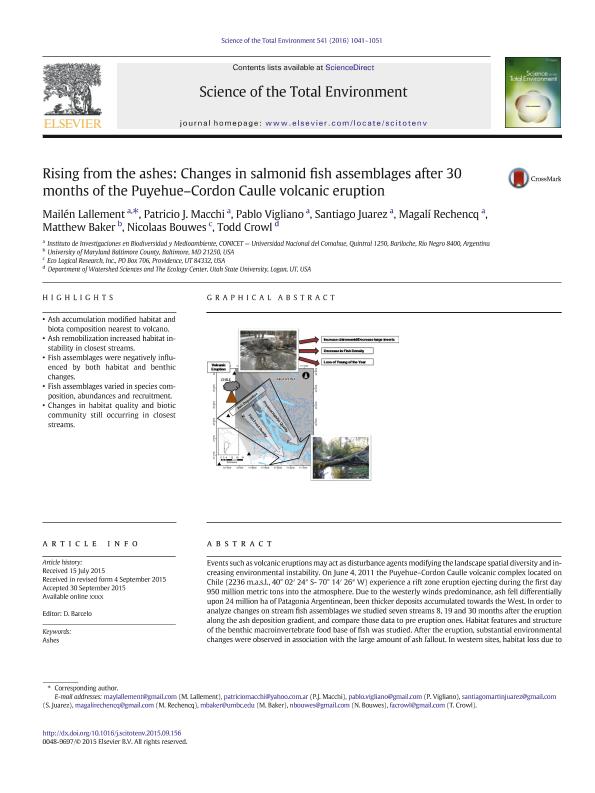Artículo
Rising from the ashes: Changes in salmonid fish assemblages after 30 months of the Puyehue-Cordon Caulle volcanic eruption
Lallement, Mailén Elizabeth ; Macchi, Patricio Jorge; Vigliano, Pablo Horacio; Juárez, Santiago Martín
; Macchi, Patricio Jorge; Vigliano, Pablo Horacio; Juárez, Santiago Martín ; Rechencq, Magali
; Rechencq, Magali ; Baker, Matthew; Bouwes, Nicolaas; Crowl, Todd
; Baker, Matthew; Bouwes, Nicolaas; Crowl, Todd
 ; Macchi, Patricio Jorge; Vigliano, Pablo Horacio; Juárez, Santiago Martín
; Macchi, Patricio Jorge; Vigliano, Pablo Horacio; Juárez, Santiago Martín ; Rechencq, Magali
; Rechencq, Magali ; Baker, Matthew; Bouwes, Nicolaas; Crowl, Todd
; Baker, Matthew; Bouwes, Nicolaas; Crowl, Todd
Fecha de publicación:
15/01/2016
Editorial:
Elsevier Science
Revista:
The Science Of Total Environment
ISSN:
0048-9697
Idioma:
Inglés
Tipo de recurso:
Artículo publicado
Clasificación temática:
Resumen
Events such as volcanic eruptions may act as disturbance agents modifying the landscape spatial diversity and increasing environmental instability. On June 4, 2011 the Puyehue-Cordon Caulle volcanic complex located on Chile (2236 m.a.s.l., 40° 02' 24? S- 70° 14' 26? W) experience a rift zone eruption ejecting during the first day 950 million metric tons into the atmosphere. Due to the westerly winds predominance, ash fell differentially upon 24 million ha of Patagonia Argentinean, been thicker deposits accumulated towards the West. In order to analyze changes on stream fish assemblages we studied seven streams 8, 19 and 30 months after the eruption along the ash deposition gradient, and compare those data to pre eruption ones. Habitat features and structure of the benthic macroinvertebrate food base of fish was studied. After the eruption, substantial environmental changes were observed in association with the large amount of ash fallout. In western sites, habitat loss due to ash accumulation, changes in the riparian zone and morphology of the main channels were observed. Turbidity was the water quality variable which reflected the most changes throughout time, with NTU values decreasing sharply from West to East sites. In west sites, increased Chironomid densities were recorded 8 months after the initial eruption aswell as lowEPT index values. These relationships were reversed in the less affected streams farther away from the volcano. Fish assemblages were greatly influenced both by habitat and macroinvertebrate changes. The eruption brought about an initial sharp decline in fish densities and the almost total loss of young of the year in themostwestern streams affecting recruitment. This effect diminished rapidly with distance fromthe emission center. Thirty months after the eruption, environmental changes are still occurring as a consequence of basin wide ash remobilization and transport.
Palabras clave:
Ashes
,
Disturbance
,
Fish Assemblages
,
Macroinvertebrates
,
Volcanic Eruption
Archivos asociados
Licencia
Identificadores
Colecciones
Articulos(CCT - PATAGONIA NORTE)
Articulos de CTRO.CIENTIFICO TECNOL.CONICET - PATAGONIA NORTE
Articulos de CTRO.CIENTIFICO TECNOL.CONICET - PATAGONIA NORTE
Articulos(INIBIOMA)
Articulos de INST. DE INVEST.EN BIODIVERSIDAD Y MEDIOAMBIENTE
Articulos de INST. DE INVEST.EN BIODIVERSIDAD Y MEDIOAMBIENTE
Citación
Lallement, Mailén Elizabeth; Macchi, Patricio Jorge; Vigliano, Pablo Horacio; Juárez, Santiago Martín; Rechencq, Magali; et al.; Rising from the ashes: Changes in salmonid fish assemblages after 30 months of the Puyehue-Cordon Caulle volcanic eruption; Elsevier Science; The Science Of Total Environment; 541; 15-1-2016; 1041-1051
Compartir
Altmétricas



